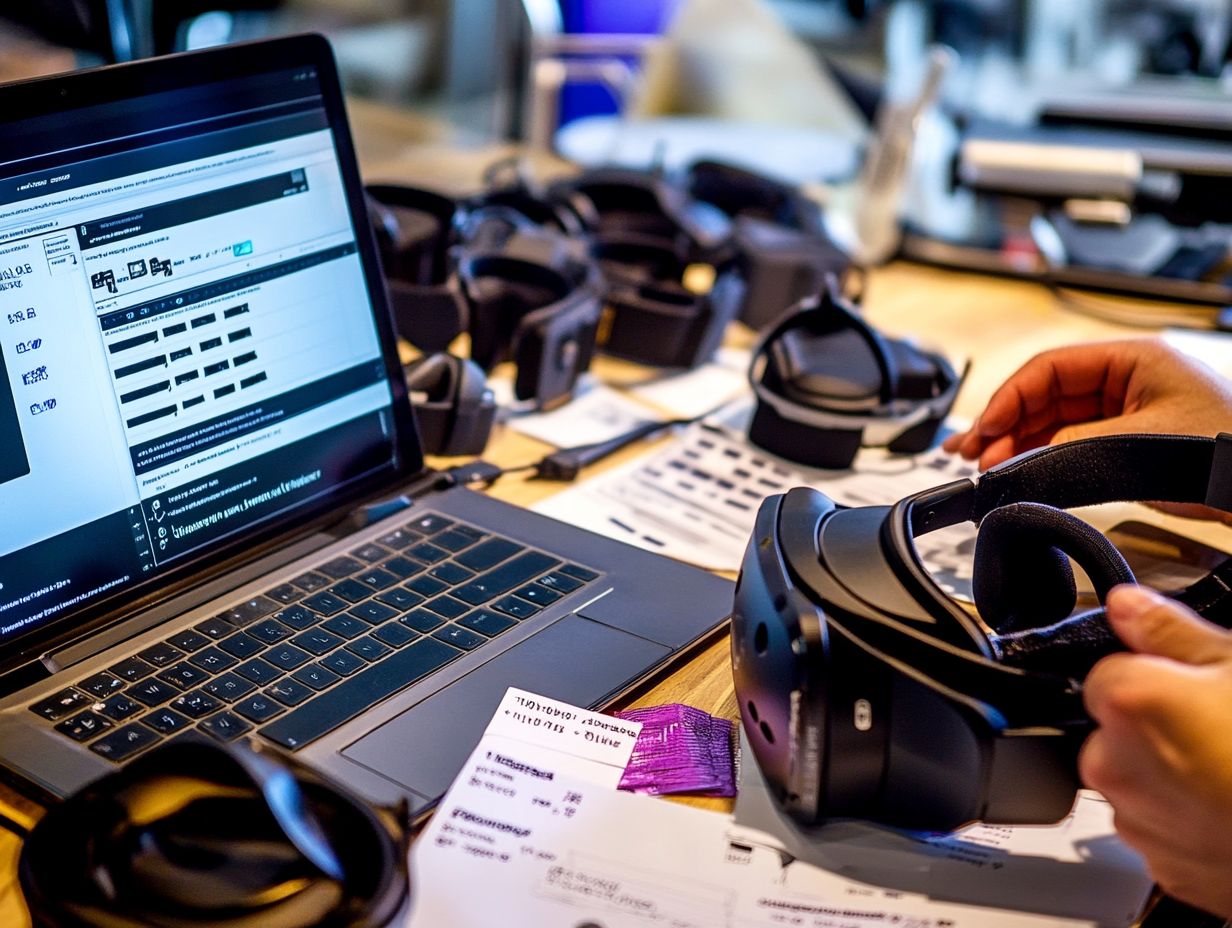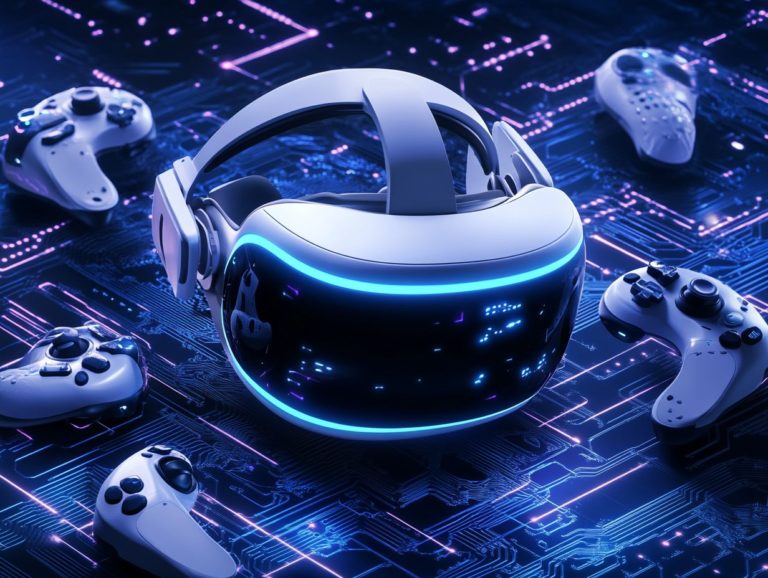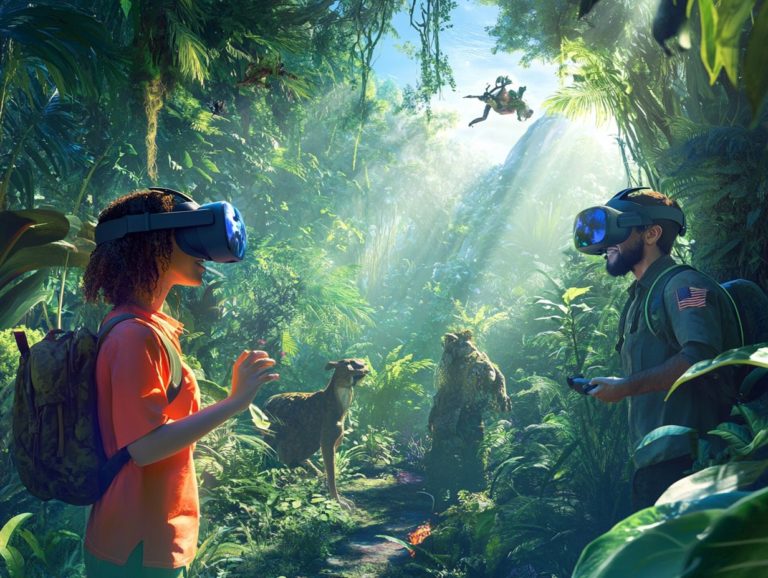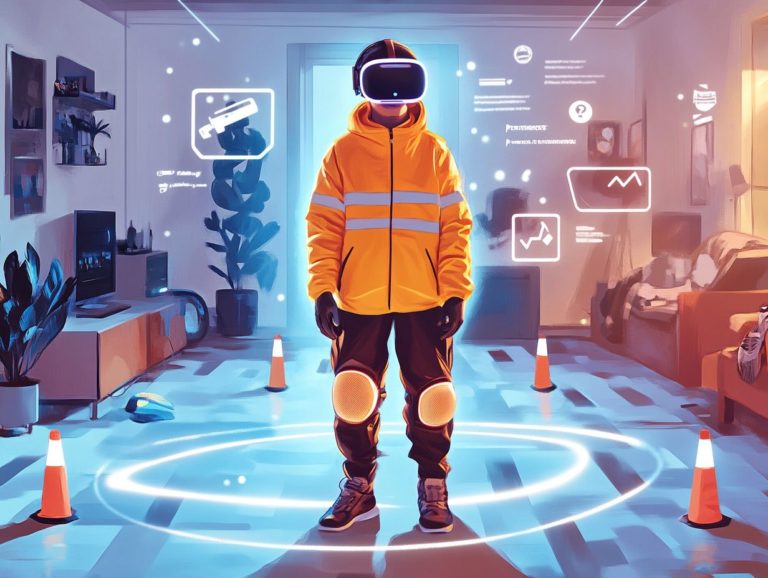how to maximize your vr budget
Virtual reality (VR) represents an exhilarating frontier in technology. It delivers immersive experiences that truly captivate audiences.
Creating high-quality VR content can come with a hefty price tag. Understanding how to keep track of your money effectively is crucial for thriving in this competitive landscape.
This article explores what a VR budget includes. It emphasizes its significance while examining the various factors that influence costs from hardware to marketing.
You ll also discover practical tips to stretch your budget further. This ensures your VR projects remain both feasible and impactful.
Contents
- Key Takeaways:
- Understanding VR Budgets
- Factors Affecting VR Budgets
- Tips for Maximizing Your VR Budget
- Frequently Asked Questions
- What is VR and why is it important to maximize my budget for it?
- How do I determine my budget for VR?
- What are some ways to save money on VR equipment?
- How can I make the most out of my VR budget?
- Are there any free resources or software available for VR?
- What should I consider when choosing VR accessories?
Key Takeaways:

Research prices to find the best deals on VR hardware and software.
Use free resources to save on development costs.
Collaborate with others to share expenses for your projects.
Manage your budget wisely to avoid overspending.
Act now to make the most of your budget!
Understanding VR Budgets
Understanding VR budgets is essential for any successful VR project. It encompasses a range of critical elements, including budget management and cost considerations.
By engaging in thorough budget planning, you enable your team to define the project scope effectively. This ensures that immersive experiences and high-quality artistry remain uncompromised.
Knowing typical budget examples helps you make informed decisions about essential resources, such as VR hardware and software development.
What is a VR Budget?
A VR budget is your detailed financial blueprint for a virtual reality project. It outlines all expenses related to hardware, software, personnel training, and technical installation.
This comprehensive financial framework not only brings direct costs into focus. It also includes essential budgeting elements vital for successful project execution.
For instance, acquiring VR headsets and necessary equipment can take up a significant chunk of your budget. Licensing fees for specialized software also add to the costs. Don t forget the investment in skilled personnel who will train users and set up immersive experiences; that s another cost that often slips under the radar.
It s crucial to factor in ongoing maintenance and potential upgrades as technology advances. This ensures your VR project remains relevant and engaging over time.
Why is it Important to Maximize Your VR Budget?
Maximizing your VR budget is key to creating amazing experiences! It s vital for delivering exceptional user experiences while maintaining a focus on artistic integrity and technological advancements, especially in competitive arenas like gaming and training programs.
By strategically allocating your funds and exploring cost-effective solutions, you can craft immersive environments that captivate users and elevate their learning or gaming experiences.
For example, a well-known gaming company adopted a resource-sharing model. This allowed them to leverage existing assets and streamline development costs. The outcome was a visually stunning game that impressed players without sacrificing quality.
In training simulations, organizations investing in modular VR components have found the ability to adapt their programs based on user feedback. This creates richer experiences while effectively managing expenses.
These examples underscore the significance of sound financial decisions in VR project planning. They ensure that creators like you can strike a balance between innovation and budgetary constraints.
Factors Affecting VR Budgets
Several factors influence your VR budget. These include the costs of hardware, software, development, production, marketing, and distribution.
Each of these elements plays a crucial role in shaping the overall financial strategy for your VR project.
Hardware and Software Costs

Hardware and software costs are significant components of your VR budget. The expenses for VR hardware such as the Meta Quest Pro, Varjo XR-4, and Vive Focus 3 can profoundly impact the quality of your immersive experience.
These costs can vary dramatically. It depends on your specific application, whether you re diving into VR training modules crafted for corporate environments or exploring cutting-edge gaming experiences designed for entertainment aficionados.
In the realm of VR training, investments often focus on high-resolution graphics features and specialized hardware. This ensures that you can convincingly simulate real-world scenarios and acquire practical knowledge relevant to your field.
Conversely, gaming applications emphasize robust graphics libraries and seamless display technologies. These deliver captivating visuals that enhance user engagement.
Understanding how hardware specifications and software demands interact is essential for you as a developer. This understanding helps you create effective and enthralling VR experiences.
Development and Production Expenses
Development and production expenses include all costs related to VR application development. This encompasses personnel training, software licenses, and the use of programming languages and 3D modeling tools.
These costs play a crucial role in shaping your overall budget. Especially when you factor in the long hours spent on labor-intensive tasks like coding and creating 3D assets.
Developers often turn to programming languages such as C# and C++, while also leveraging advanced 3D modeling tools like Blender or Unity.
Expenses for specialized hardware and software can add up quickly. Don t forget the potential costs associated with acquiring licenses for various platforms.
Meticulous planning for these elements is vital. They directly influence the quality and scalability of the final VR experience, ultimately determining its success in a competitive market.
Marketing and Distribution Costs
Marketing and distribution costs are crucial for making your VR project shine! They significantly influence how effectively your product reaches its target audience and performs in the competitive market.
To navigate the ever-changing landscape of VR gaming, harness a diverse array of marketing strategies. Consider social media campaigns, influencer partnerships, and targeted ads on platforms where gamers gather.
Exploring emerging distribution channels, such as VR marketplaces and digital platforms, can boost your visibility while trimming costs often associated with traditional retail.
Don t underestimate the power of effective promotional tactics engaging trailers and immersive demos can capture attention, spark interest, and drive pre-sales.
By prioritizing innovative marketing efforts, you can tackle budget constraints while ensuring your projects resonate with the expanding community of virtual reality enthusiasts.
Tips for Maximizing Your VR Budget
Maximize your VR budget by using smart strategies!
Start with thorough research to understand the landscape. Engage in comparison shopping to find the best deals, and leverage free and open-source resources wherever possible. Collaborating with partners can also enhance your efforts. Don’t underestimate the power of effective budget optimization techniques to stretch your dollars further.
By thoughtfully integrating these strategies, you’ll unlock the full potential of your VR investment.
Research and Comparison Shopping
Research and comparison shopping are essential practices when managing a VR budget. This is particularly true for selecting the right hardware and software. These processes help maximize your investment and allow you to make informed buying decisions.
By analyzing various products and their prices, you can identify the most suitable options that align with your specific project needs without overspending.
Conducting market research unveils current pricing trends and provides valuable insights into product performance and user feedback. This can greatly influence your decision-making process.
Ultimately, this strategic approach leads to enhanced project outcomes. It ensures that your resources are allocated efficiently and fosters innovation and excellence in your virtual reality experiences.
Utilizing Free and Open-Source Resources

Utilizing free and open-source resources can significantly enhance your budget optimization in VR projects. These resources allow access to essential tools for VR content generation without extra costs.
These resources include a variety of platforms and libraries, such as:
- Blender for 3D modeling
- Godot Engine for game development
- A-Frame for building web-based VR environments
Incorporating these tools lets you quickly turn your ideas into reality! You can prototype and iterate rapidly, which makes it easier to stick to project timelines and budgets.
Engaging with community-driven platforms offers valuable support. This helps you troubleshoot issues effectively. A collaborative approach fosters innovation and lets you explore creative solutions while minimizing financial constraints. It’s an ideal strategy for both emerging and experienced VR developers.
Collaborating with Others
Collaborating with others, like industry partners or research institutions, unlocks valuable insights and shared resources. This significantly enhances the quality and cost-effectiveness of your VR training and immersive technology projects.
Pooling expertise and innovative ideas enables you to craft engaging and impactful simulations that optimize learning outcomes. For instance, a successful partnership between a leading tech company and a prominent educational institution resulted in a remarkable 30% increase in learner retention rates.
Utilizing collaborative feedback loops allows for real-time adjustments. This refines user experiences as you go. Such synergy sparks creativity and accelerates project timelines, creating a win-win scenario for everyone in the ever-evolving landscape of immersive training solutions.
Effective Budget Management Strategies
Effective budget management strategies are vital for ensuring that your VR projects stay within financial constraints while maximizing output and maintaining quality. This requires a thoughtful approach to financial planning and cost considerations.
To achieve this, you can employ several practical methods, such as prioritizing essential features and using cost-effective tools and resources. Clear communication among your team members is crucial for managing financial resources effectively.
Conducting thorough market research before launching your project helps identify potential expenses and revenue streams. This enables more well-considered choices. Setting up progress tracking with set goals can further enhance your budget adherence by providing checkpoints to evaluate expenses against projections.
By integrating these actionable insights into your financial strategies, you ll optimize your budgets and ensure sustainable development throughout the project lifecycle.
Frequently Asked Questions
What is VR and why is it important to maximize my budget for it?
VR stands for virtual reality, a technology that creates a simulated environment for users to interact with. Maximizing your VR budget is crucial as it ensures you get the best return on your investment!
How do I determine my budget for VR?

Consider the cost of VR equipment, software, and any additional accessories you may need. Factor in any ongoing maintenance or subscription fees. It’s important to have a clear understanding of your budget before making purchases.
What are some ways to save money on VR equipment?
One way to save money is to purchase used or refurbished equipment. You can also look for deals or discounts from reputable retailers. You can also choose lower-end VR equipment or consider renting instead of buying.
How can I make the most out of my VR budget?
To maximize your VR budget, prioritize your needs and wants. Focus on essential equipment and software that will enhance your VR experience. Additionally, learning how to optimize your VR setup for performance can make a significant difference. Research and compare prices to find the best deals. Setting a budget and sticking to it is also helpful.
Have questions or want to share your experiences with VR budgeting? Reach out and let s connect!
Are there any free resources or software available for VR?
Yes! There are many free resources and software for VR. Some platforms offer free demos or trials, and you can find open-source options as well.
Check out app stores and online platforms for free VR games and experiences. Don’t miss out on amazing free content!
What should I consider when choosing VR accessories?
When selecting VR accessories, think about whether they work with your VR headset. Also, consider their quality and durability, along with the cost.
Reading reviews can help you compare different options before you buy. Make an informed choice for the best experience!





